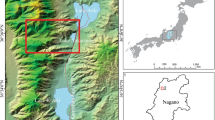Abstract
Michigan has three main zones of evaporite karst: collapse breccia in Late Silurian deposits of the Mackinac Straits region; breccia, collapse sinks, and mega-block collapse in Middle Devonian deposits of Northern Lower Michigan, which overlaps the preceding area; and areas of soil swallows in sinks of Mississippian deposits between Turner and Alabaster in Arenac and Iosco counties, and near Grand Rapids in Kent County. The author has focused his study on evaporite karst of the Middle Devonian deposits. The Middle Devonian deposits are the Detroit River Group: a series consisting of limestone, dolomite, shale, salt, gypsum, and anhydrite. The group occurs from subcrop, near the surface, to nearly 1400 feet deep from the northern tip of the Southern Peninsula to the south edge of the “solution front.” Glacial drift is from zero to 350 feet thick. Oil and gas exploration has encountered some significant lost-circulation zones throughout the area. Drilling without fluid returns, casing-seal failures, and lost holes are strong risks in some parts of the region. Lost fluid returns near the top of the group in nearby areas indicate some karst development shortly after deposition. Large and irregular lost-circulation zones, linear and patch trends of large sink holes, and 0.25 mile wide blocks of down-dropped land in the northern Lower Peninsula of Michigan were caused by surface-and ground-water movement along faults into the Detroit River Group. Glaciation has removed some evidence of the karst area at the surface. Sinkhole development, collapse valleys, and swallows developed since retreat of the glacier reveal an active solution front in the Detroit River Group.
Similar content being viewed by others
References
ASHLEY, J.W., 1991?, The nature of the Conllindale Depression. Copy of an unpublished report received from the author in 1996 with no references to source, Figure 8.
BLACK, T.J., 1983, Selected views of tectonics, structure, and karst in Northern Lower Michigan,in R.E. Kimmel (ed.) Tectonics, Structure, and Karst in Northern Lower Michigan. Michigan Basin Geological Society Fieldtrip Guidebook, p. 11–35.
BLACK, T.J., 1995, Karst geology of the Northeast Lower Peninsula, Michigan, A Field Conference. Michigan Basin Geological Society Fieldtrip Guidebook, p. 22–23.
ELOWSKI, R.C. and OSTRANDER, A.G., 1977, Gypsum karst and related features in the Michigan Basin, Official 1977 Guidebook, Alpena, Michigan, National Speleological Society, p. 31–39.
LANDES, K.K., EHLERS, G.M., and STANLEY, G.M., 1945, Geology of the Mackinac Straits Region and Subsurface Geology of Northern Southern Peninsula:Michigan Geological Survey, Publication 44, Geological Series, p. 143–150.
WOLD, R.J., 1980, Review of Lake Michigan Seismic Reflection Data, Open File Report 80-902, U.S. Department of the Interior, Geological Survey, 36 p.
Author information
Authors and Affiliations
Rights and permissions
About this article
Cite this article
Black, T.J. Evaporite karst of Northern Lower Michigan. Carbonates Evaporites 12, 81–83 (1997). https://doi.org/10.1007/BF03175805
Received:
Accepted:
Published:
Issue Date:
DOI: https://doi.org/10.1007/BF03175805




